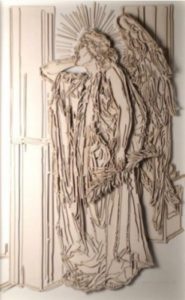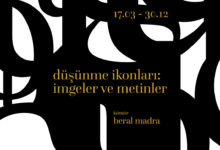ESRA CARUS
NOBODY’S FAULT Banality of Evil / HİÇ KİMSENİN SUÇU Kötülüğün Sıradanlığı
05May/Mayıs – 11 June/Haziran 2016
Esra Carus’a corpus of work gracefully commemorates the 400’th anniversary of Shakespeare’s death (23 April 1616).
Carus has created a series of Shakespeare characters from Hamlet, Ophelia, Macbeth, Othello, Desdemona, Romeo and Juliet, King Lear, with allusions to mythological and archetypical characters. With a distinguishing reference to the current socio-political disorders and cultural confusions in Turkey and in the region Carus, grounded her initial idea to Hanna Arendt’s Banality of Evil and together with Kentauros, Mermaid, Satry, Medusa presents snake, owl, cat, bat, goat, as ambiguous animals believed to symbolize the evil.
“What did she really mean?” as Judith Butler has asked on the controversial atribute “banality” of Arendt in her essay (1) is explained as : “She feared that what had become “banal” was non-thinking itself. This fact was not banal at all, but unprecedented, shocking, and wrong.” This is the key point of Carus’s attempt to provoke a process of thinking through her mythological characters and through Shakespeare’s literary genius.
Why is Carus using mythological characters? Mythology has been a decisive narrative for artists since Antiquity. The magnanimous art-historical production created a vast possibility of philosophical and psychoanalytical statements, criticism and discussion on the meaning of mythology in human civilization. The common dictionary meaning of “myth” is: a traditional and art-historical narrative usually involving supernatural or imaginary persons and worlds which embody prevalent concepts on natural or social occurrences and experiences.
What we usually refer to when we talk of the mythological roots is the earlier pantheon of Greek gods and goddesses that has been the main theme of historical art works and literature since the Antiquity . In today’s post-narrative context the artists can expand on the meaning of myths as a way of creating metaphors for present socio-cultural discourse or codes. The intention is always to utilize the myths beyond their contents and convey a multiple possibility to perceive the meaning of the art work.
This intention of the artist using mythology as manifested in Esra Carus’s works is mainly based on the ideas of Jung und Roland Barthes’s. Jung mainly interpreted myths and their meaning in the realm of individual psyche and intellect. He therefore examined the origins of myths and legends, and their influence to the religions and through religions to the cultures. Within the Modernist discourse man is on a quest towards self-realization, and according to Jung myths serve as fundamental signs to this progression. Barthes linguistic research again declares myth in its most basic form as and individual process and as a special type of speech. According to Barthes people use myths as a way of expressing their thoughts, and myths present and ethos, an ideology or set of values.
Carus’s work corpus consists of paper-thin white porcelain or layered hard-paper figures and drawings on paper. Paper has always been the primary medium for artistic expression. Artists conceive and develop their initial ideas and images on paper. Carus, in combination with her drawings has extended this primordial practice on paper to creating three-dimensional artworks with different textures of paper into intriguing layered forms by using its elasticity.
While Carus’s figures have references to art-historical figures, they also reflect the skeptical aesthetics of today’s comparative perception of mythologies. She adjusts their prescriptive identity to today’s problematic identity and system patterns. The elegant Mermaid, embracing a snake and holding an apple is a clear reference to the Eve and the original sin and it is juxtaposed here to the stereotype tragedy of Romeo Juliet, to the foolishness and loss of reality of this famous couple. Lady Macbet’s physiognomy when she is putting the crown to her head reflects her deadly ambitions and this scene is accentuated with the snakes that extends her identity to Medusa’s intentions. Hamlet, disguised in a lawyers robe and weighing the scull in a scales indicates the rising racist and sectarian judicial approach. Kral Lear’s unique local costume and goat horns are attributes to vanity and an association to the Seven Deadly Sins. Kentauros in Carus’s realm of interpretation is Othello with a military uniform and an expression of remorse. While he regrets all his sins he also symbolizes the irresponsibility of the bureaucracy that anonymously continues to commit crimes.
Hannah Arendt’s Banality of Evil, published in 1963 has wakened the people to the existing evil system of normalizing the unthinkable. Her statement still accentuates the fact that that people who carry out unthinkable and unspeakable crimes that has tragically accumulated in our times are ordinary individuals who simply accept the principles of their questionable nation-state ideology and participate in any ongoing ruling with the psychology of irresponsible submitting. Carus enlivens this ongoing psychosocial complexity within psychoanalytical power of Mythology.
Beral Madra
http://www.theguardian.com/commentisfree/2011/aug/29/hannah-arendt-adolf-eichmann-banality-of-evil
*****************************************************************************************
Esra Carus’un, Kuad Galeri’deki kişisel sergisi kağıt, karton ve porselenden 3 boyutlu ve desen yapıtlarıyla Shakespeare’in 400. Yılı (23 Nisan 1616) kutlamalarına bir katkı sunuyor ve Shakespeare’in evrenselleşmiş anlatı altyapısını kullanarak, güncel siyasal, toplumsal, kültürel gelişmelere ilişkin metaforlar oluşturuyor.
Shakespeare‘in “Hamlet”, “Macbeth”, “Othello”, “Romeo ve Juliet”, “King Lear” oyunlarından karakterler seçerek, bu karakterlerin günümüzdeki anlamları üstüne odaklanan Carus, bu karakterlerin çoklu anlamları ve simgeledikleri kavramları kullanarak ikinci bir göndermeyle Hannah Arendt’in “Kötülüğün Sıradanlığı”na doğru bir yolculuğa çıkarıyor izleyiciyi. Sergide izlenen Kentauros, Satir, Medusa, deniz kızı gibi mitolojik karakterler ve keçi, yılan, karga, baykuş, yarasa, kedi gibi ikilemli hayvanlar insanın yaşadığı zaman ve mekan içinde doğa ve toplumsal sistemler arasındaki ilişkileri anlamak ve sorunları çözebilmek için kullandığı çoklu bir imgelem. Mitoloji Antik çağlardan başlayarak, sanatçıların başvurduğu bir büyük-anlatı kaynağı; Modernizmde ise örneğin Picasso’da, Post-modernizmde de “Yeni Ekspresyonist” akım içinde izlediğimiz türleriyle…
Mitolojinin 20.yy’daki yorumcusu Roland Barth’a göre Mitolojik anlatılar şifrelerdir ve insanın yaşadığı doğal ve fiziki koşullar konusunda gerçekmiş gibi özellikler ve değerler içerir; oysa bu içerikler insan zihninin ürünüdür ve her dönemin koşullarına göre değişir. Mitolojik öyküler kurgu olduğu için anlatanın görüşlerini, düşüncelerini, öngörülerini yansıtır. Tıpkı bu sergide Esra Carus’un ürettiği figürler ve bu figürler arasında kurguladığı ilişkilerin bize önerdiği yorumlar gibi.
Carus, sergisi dolayısıyla yaptığı açıklamada, içinde yaşadığımız küresel siyasal-ekonomik-kültürel krizlerin, savaşların, terörün ve insan kıyımının yarattığı kötülüğü işaret ediyor: “Kötülük kavramının üzerinde durmamın nedeni, hem duygusal hem fiziksel olarak, insan kaynaklı, küresel bir önlenemez felaket durumunun etkisi altında olduğumuz gerçeğidir” diyor.
Sergide yer alan yapıtlar Esra Carus’un ustalıkla kullandığı iki malzemeden oluşuyor: Kağıt ve kağıt etkisi veren porselen. Kağıt sanatsal ifade için birincil bir malzemedir; sanatçılar düşünce ve kavramlarını önce kağıt üstünde oluşturur; Carus bu birincil işlevi daha da öteye taşıyarak kağıdın esnekliğini kullanarak ve kağıt veya karton kesme tekniğiyle üçboyutlu imgeler oluşturuyor. Porselende de kağıdın yarattığı o sade ama etkileyici sonuca incelikle ulaşıyor.
Beral Madra






